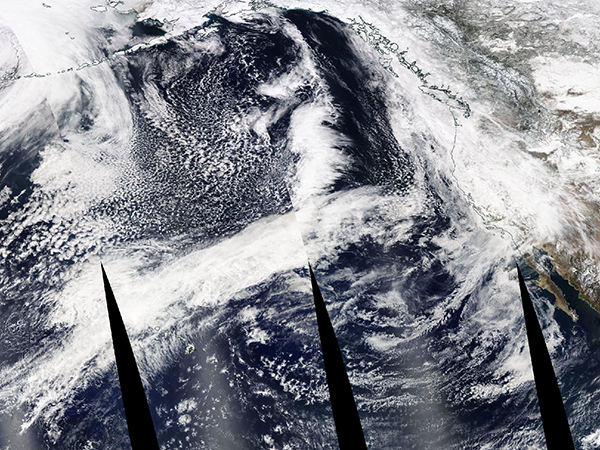Images
March 21, 2023 - Another Atmospheric River approaches California
Tweet
Another atmospheric river was bearing down on California on March 19, 2023, threatening a rain-weary and waterlogged region with the potential for high winds, soaking rain, and heavy mountain snow. The Moderate Resolution Imaging Spectroradiometer (MODIS) on board NASA’s Terra satellite acquired a true-color image of the long, narrow band of rain-filled cloud stretching over the Pacific Ocean on that same day. This storm, expected to begin on March 20, will be the third atmospheric river to strike the state this month alone. At least nine others soaked the state between December 2022 and January 2023.
Atmospheric rivers—vast airborne corridors of water vapor—are some of the most hazardous storm types in the middle latitudes because of how much precipitation they can produce. The first March atmospheric river dumped 5 to 13 inches (13 to 33 centimeters) of rain over parts of Monterey County on March 10-11, 2023. A second storm that struck on March 14 brought peak gusts of 77 miles (124 kilometers) per hour, recorded at the San Francisco airport. Another inch of rain fell on Sacramento and 3 to 5 inches fell on Chico and Redding to the north. By mid-March, soils in many places have become saturated, increasing the risk of flooding and mudslides as fresh rains fall.
The series of atmospheric rivers also piled snow on the Sierra Nevada mountains, closing roads and leaving some residents stranded. According to the Central Sierra Snow Laboratory, a University of California Berkeley research station located in the northern Sierra Nevada, the atmospheric rivers pushed snow totals since October 1 to 55.7 feet, the third highest seen at the station at Donner Pass since it opened in 1946.
According to the National Weather Service, Southern California could see wind gusts near 75 mph (121 km/h) and gusts up to 50 mph (80.5 km/h) over the next day or two. They warn that heavy rain is likely to lead to rapid runoff and areas of flooding across Southern California. Heavy snowfall will be the primary hazard in the high mountains of south/central Sierra Nevada and Southern California, with additional accumulations of up to 3-4 feet (0.9-1.2 meters) in spots, with potential damage to infrastructure in areas already digging out of record snowpack this year.
The storm will also sweep inland, bringing strong wind, snow, and rain to the Southwest, central Great Basin, and south/central Rocky Mountains. Heavy rain and flash flooding is likely to affect areas as far south at central Arizona.
Image Facts
Satellite:
Terra
Date Acquired: 3/19/2023
Resolutions:
1km (9 MB),
Bands Used: 1,4,3
Image Credit:
MODIS Land Rapid Response Team, NASA GSFC
Tweet
Another atmospheric river was bearing down on California on March 19, 2023, threatening a rain-weary and waterlogged region with the potential for high winds, soaking rain, and heavy mountain snow. The Moderate Resolution Imaging Spectroradiometer (MODIS) on board NASA’s Terra satellite acquired a true-color image of the long, narrow band of rain-filled cloud stretching over the Pacific Ocean on that same day. This storm, expected to begin on March 20, will be the third atmospheric river to strike the state this month alone. At least nine others soaked the state between December 2022 and January 2023.
Atmospheric rivers—vast airborne corridors of water vapor—are some of the most hazardous storm types in the middle latitudes because of how much precipitation they can produce. The first March atmospheric river dumped 5 to 13 inches (13 to 33 centimeters) of rain over parts of Monterey County on March 10-11, 2023. A second storm that struck on March 14 brought peak gusts of 77 miles (124 kilometers) per hour, recorded at the San Francisco airport. Another inch of rain fell on Sacramento and 3 to 5 inches fell on Chico and Redding to the north. By mid-March, soils in many places have become saturated, increasing the risk of flooding and mudslides as fresh rains fall.
The series of atmospheric rivers also piled snow on the Sierra Nevada mountains, closing roads and leaving some residents stranded. According to the Central Sierra Snow Laboratory, a University of California Berkeley research station located in the northern Sierra Nevada, the atmospheric rivers pushed snow totals since October 1 to 55.7 feet, the third highest seen at the station at Donner Pass since it opened in 1946.
According to the National Weather Service, Southern California could see wind gusts near 75 mph (121 km/h) and gusts up to 50 mph (80.5 km/h) over the next day or two. They warn that heavy rain is likely to lead to rapid runoff and areas of flooding across Southern California. Heavy snowfall will be the primary hazard in the high mountains of south/central Sierra Nevada and Southern California, with additional accumulations of up to 3-4 feet (0.9-1.2 meters) in spots, with potential damage to infrastructure in areas already digging out of record snowpack this year.
The storm will also sweep inland, bringing strong wind, snow, and rain to the Southwest, central Great Basin, and south/central Rocky Mountains. Heavy rain and flash flooding is likely to affect areas as far south at central Arizona.
Image Facts
Satellite:
Terra
Date Acquired: 3/19/2023
Resolutions:
1km (9 MB),
Bands Used: 1,4,3
Image Credit:
MODIS Land Rapid Response Team, NASA GSFC




